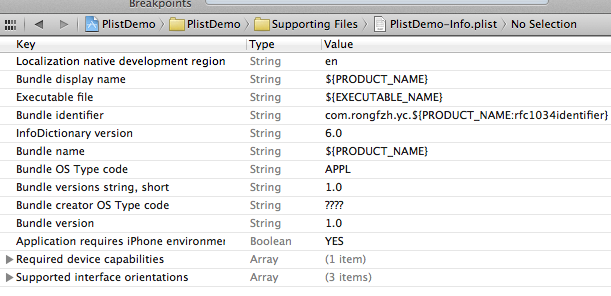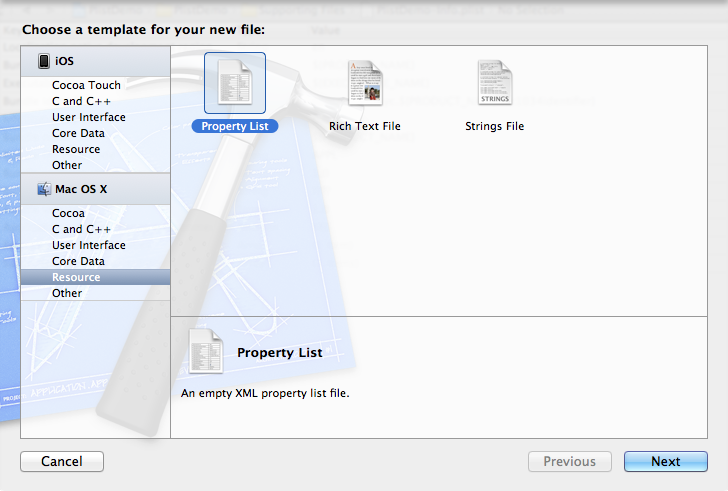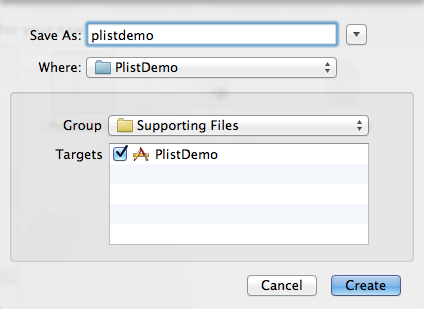IOS學習之 plist檔案的讀寫
阿新 • • 發佈:2019-02-05
在做IOS開發時,經常用到到plist檔案, 那plist檔案是什麼呢? 它全名是:Property List,屬性列表檔案,它是一種用來儲存序列化後的物件的檔案。屬性列表檔案的副檔名為.plist ,因此通常被稱為 plist檔案。檔案是xml格式的。
Plist檔案通常用於儲存使用者設定,也可以用於儲存捆綁的資訊
我們建立一個專案來學習plist檔案的讀寫。
1、建立專案Plistdemo
專案建立之後可以找到專案對應的plist檔案,開啟如下圖所示:

在編輯器中顯示類似與表格的形式,可以在plist上右鍵,用原始碼方式開啟,就能看到plist檔案的xml格式了。
2、建立plist檔案。
按command +N快捷鍵建立,或者File —> New —> New File,選擇Mac OS X下的Property List


建立plist檔名為plistdemo。
開啟plistdemo檔案,在空白出右鍵,右鍵選擇Add row 新增資料,新增成功一條資料後,在這條資料上右鍵看到value Type選擇Dictionary。點加號新增這個Dictionary下的資料

新增完key之後在後面新增Value的值,新增手機號和年齡
建立完成之後用source code檢視到plist檔案是這樣的:
<?xml version="1.0" encoding="UTF-8"?> <!DOCTYPE plist PUBLIC "-//Apple//DTD PLIST 1.0//EN" "http://www.apple.com/DTDs/PropertyList-1.0.dtd"> <plist version="1.0"> <dict> <key>jack</key> <dict> <key>phone_num</key> <string>13801111111</string> <key>age</key> <string>22</string> </dict> <key>tom</key> <dict> <key>phone_num</key> <string>13901111111</string> <key>age</key> <string>36</string> </dict> </dict> </plist>
3、讀取plist檔案的資料
- (void)viewDidLoad { [super viewDidLoad]; //讀取plist NSString *plistPath = [[NSBundle mainBundle] pathForResource:@"plistdemo" ofType:@"plist"]; NSMutableDictionary *data = [[NSMutableDictionary alloc] initWithContentsOfFile:plistPath]; NSLog(@"%@", data);//直接列印資料。 }
打印出來的結果:
PlistDemo[6822:f803] {
jack = {
age = 22;
"phone_num" = 13801111111;
};
tom = {
age = 36;
"phone_num" = 13901111111;
};
}這樣就把資料讀取出來了。
4、建立和寫入plist檔案
在開發過程中,有時候需要把程式的一些配置儲存下來,或者遊戲資料等等。 這時候需要寫入Plist資料。
寫入的plist檔案會生成在對應程式的沙盒目錄裡。
接著上面讀取plist資料的程式碼,加入了寫入資料的程式碼,
- (void)viewDidLoad
{
[super viewDidLoad];
//讀取plist
NSString *plistPath = [[NSBundle mainBundle] pathForResource:@"plistdemo" ofType:@"plist"];
NSMutableDictionary *data = [[NSMutableDictionary alloc] initWithContentsOfFile:plistPath];
NSLog(@"%@", data);
//新增一項內容
[data setObject:@"add some content" forKey:@"c_key"];
//獲取應用程式沙盒的Documents目錄
NSArray *paths=NSSearchPathForDirectoriesInDomains(NSDocumentDirectory,NSUserDomainMask,YES);
NSString *plistPath1 = [paths objectAtIndex:0];
//得到完整的檔名
NSString *filename=[plistPath1 stringByAppendingPathComponent:@"test.plist"];
//輸入寫入
[data writeToFile:filename atomically:YES];
//那怎麼證明我的資料寫入了呢?讀出來看看
NSMutableDictionary *data1 = [[NSMutableDictionary alloc] initWithContentsOfFile:filename];
NSLog(@"%@", data1);
// Do any additional setup after loading the view, typically from a nib.
}
在獲取到自己手工建立的plistdemo.plist資料後,在這些資料後面加了一項內容,證明輸入寫入了。
怎麼證明新增的內容寫入了呢?下面是列印結果:

程式碼地址:https://github.com/schelling/YcDemo/tree/master/PlistDemo
